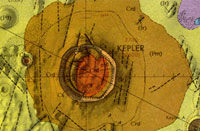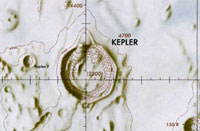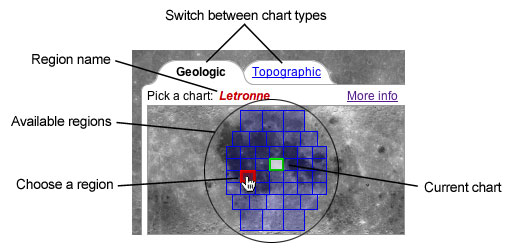You can use the Google Moon Charts layer for anything from studying lunar geology
to planning your own mission to the Moon. These maps were originally created during the 1960s in
preparation for the Apollo program.
They cover most of the front of the moon, the side that is visible from Earth. The geologic maps
will tell you all about the rocks and minerals found in different places on the moon and how they
got there, so you can plan where you want to go. The topographic maps will give you a clear
picture of the terrain, so you can plan how to get there.

Example geologic chart
|

Example topographic chart
|
To use the charts, first turn on the Charts layer in Google Moon,
and then pick the chart type and region you want from the panel that appears in the lower-right:
 The Geologic charts were produced from the USGS Geologic Atlas of the Moon, and the Topograhic
charts were produced from USAF/NASA LAC Lunar Chart series. If you want to download the complete
maps, they are archived at the Lunar and Planetary Institute. Just remember the region name
for the chart, and then pick the map type here:
In order to view the highest-resolution (300dpi) versions of the downloadable maps you
will need special JPEG 2000 image viewing software. However, you should be able to open
the other versions (750dpi and 150dpi) in almost any modern image viewer.
The Geologic charts were produced from the USGS Geologic Atlas of the Moon, and the Topograhic
charts were produced from USAF/NASA LAC Lunar Chart series. If you want to download the complete
maps, they are archived at the Lunar and Planetary Institute. Just remember the region name
for the chart, and then pick the map type here:
In order to view the highest-resolution (300dpi) versions of the downloadable maps you
will need special JPEG 2000 image viewing software. However, you should be able to open
the other versions (750dpi and 150dpi) in almost any modern image viewer.
You may notice that the downloaded charts look different than they appear in Google Moon.
This is because we have warped the charts to line up with Google Moon's Mercator projection.
This also means that, as we indicate on the charts themselves, the original printed scale and
projection information may no longer apply in Google Moon. Also, because these maps were created
a long time ago, in some places they do not line up perfectly with modern maps that have been
adjusted based on more recent calculations of exactly where things are on the Moon.
Happy exploring!
The USGS Geologic Atlas of the Moon and
the Lunar Chart (LAC) Series are provided by the Lunar and Planetary Institute, managed by USRA. 



